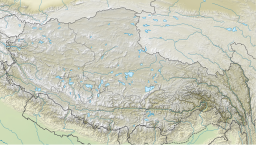| Cuona Lake | |
|---|---|
| Tsonag Lake | |
 Tsonag Lake, from the Qingzang Railway train window | |
| Location | Amdo County, Nagqu, Tibet Autonomous Region |
| Coordinates | 32°1′58″N 91°28′43″E / 32.03278°N 91.47861°E |
| Type | lake |
| Surface area | 300 square kilometres (120 sq mi) |
| Surface elevation | 4,594 metres (15,072 ft) |
Cona, also Cuona Lake or Tsonag Lake (simplified Chinese: 错那湖; traditional Chinese: 錯那湖; pinyin: Cuònà Hú), is a major lake of northern Tibet Autonomous Region, China. It is located in Amdo County, Nagqu, west of the road between Nagqu Town and Pana Town. The lake is considered holy to the Tibetans especially in the Bon religion, as it is seen as the "soul lake" of the Razheng Living Buddha.[1] The smaller Ganong Lake lies almost adjacent to the southeast.

Its area is approximately 300 square kilometres (120 sq mi), and it is at 4,594 metres (15,072 ft) above sea level making it one of the world's higher freshwater lakes. The lake is the source of the Gyalmo Nagqu, the headwater of the Salween River.
Tsonag Lake can be observed on the right (west) as the train passes Cuonahu railway station on Qingzang Railway, going south toward Lhasa.[2]
See also
[edit]References
[edit]- ^ An, Caidan; 刘浚; 李金慧; 谢涛 (2003). Travel Guide to Tibet of China. China Intercontinental Press. p. 18. ISBN 978-7-5085-0374-5. Retrieved 9 April 2012.
- ^ 错那湖 (互动百科) Archived 2012-09-18 at the Wayback Machine (in Chinese)


Well, that’s interesting to know that Psilotum nudum are known as whisk ferns. Psilotum nudum is the commoner species of the two. While the P. flaccidum is a rare species and is found in the tropical islands. Both the species are usually epiphytic in habit and grow upon tree ferns. These species may also be terrestrial and grow in humus or in the crevices of the rocks.
View the detailed Guide of Psilotum nudum: Detailed Study Of Psilotum Nudum (Whisk Fern), Classification, Anatomy, Reproduction